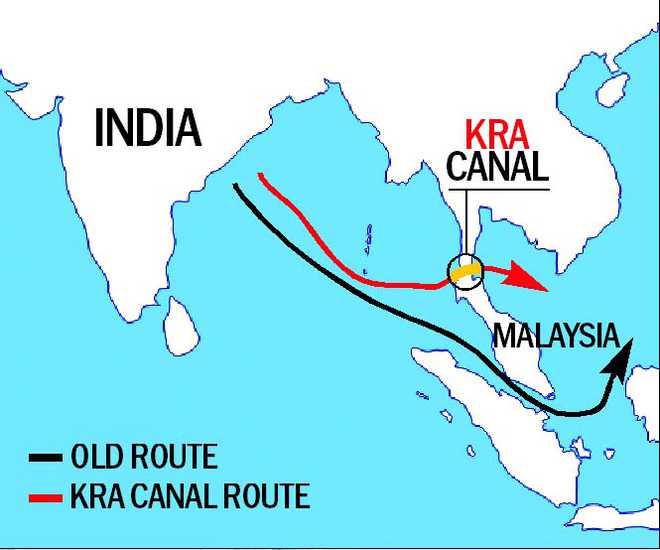Vivek Katju
Ex-Secretary, Ministry of External Affairs
I first heard of the ‘Kra canal’ in Kuala Lumpur 25 years ago where I was posted as the Deputy High Commissioner. A Malaysian geographer friend who was on a team conducting a quiet study on the project’s feasibility told me that the physical construction of the canal which would link the Andaman Sea to the Gulf of Thailand traversing the Kra Isthmus was doable but its economics, domestic politics, and, even more, its geopolitics, were problematic. Clearly, the project was not pursued further by the interested party.
In giving up on the project, the party had followed the example of others who had considered it since it was first imagined in the 17th century by a Thai monarch. Now, however, the situation appears to be changing for a weight of opinion is developing in its favour. China is relentlessly pushing it and has worked hard to foster a strong lobby for it in Thailand. Reports indicate that Thai Prime Minister Prayut Chan-o-cha, who had earlier declared that it was not a Thai priority, has asked the country’s National Security Council and the National Economic and Social Development Board to examine it. No doubt the former body will look at its security implications while the latter will consider its economic aspects.
The Kra canal which is expected to take a decade to get completed, will reduce the distance for ships sailing currently via the busy and narrow Malacca Straits from the Persian Gulf to the east by at least 1,200 km. Merchant ships which wish presently to avoid the Malacca Straits have to go further south to the Sunda or the Lombok Straits considerably increasing the distance to the east. Thus, prima facie the Kra canal, which at present estimates will cost around $30 billion — this figure will surely go up — makes sense, but its economic and strategic viability have yet to be fully established. Its Thai proponents argue that its financial viability must take into account both the volume of traffic and the economic activity generated through the Special Economic Zones (SEZs) that will be set up as part of the project.
China is willing to put in the money for the canal but will it be ready to subsidise it for its strategic purposes? That remains to be seen (and is perhaps unlikely because it will become a precedent for unviable BRI projects), despite the strategic advantages that it will bring. The Malacca choke makes China uneasy, for it is not only dependent on West Asian oil which passes through the straits, but also its general trade uses these waters. Hence, the canal alternative is strategically valid.
A principal historical Thai strategic inhibition is that it will notionally ‘separate’ the country’s southern provinces of Pattani, Yala and Narathiwat from the rest of the country. Thailand is Buddhist and ethnically Tai but these provinces are Muslim and Malay. They are part of the Malay world but along with some other Malay territories were annexed by an expanding Thai kingdom around 1785. Under the Anglo-Thai treaty of 1909, Thailand relinquished its claims to some Malay territories which are now part of Malaysia and its sovereignty over these provinces was recognised. These provinces have always been restless but have witnessed an insurgency since 2004. Its current intensity is low but alienation is substantial and violent acts continue. More than 6,000 have died in the past 14 years. Thailand can create military installations to the canal’s south to ensure effective counter-terrorism but the way the strategic landscape by the Thai elite is imagined will need to change.
The Kra canal’s impact on ASEAN will go beyond the re-orientation of shipping, though that too will be substantial and adverse on Singapore and to an extent on Malaysian ports. Conversely, some ports in Vietnam may benefit. If the SEZs take off, they will attract investments that would have gone elsewhere. However, Singapore’s attractions as a financial centre and its ability to strengthen itself as a hi-tech base are great, even as it may have to lose its pivotal place as a shipping hub.
The US has not taken an official position on the project but is wary of enhanced Chinese presence in the Indian Ocean. The European states are not concerned with that aspect and look to gaining work for their companies in the project construction. Other countries will not be overly concerned. International civil society and concerned global organisations will look at the canal’s environmental impact more than anything else.
There is no doubt that the Kra canal is part of China’s grand design in the waters that surround India and in the Indian Ocean. It is gaining access or acquiring ports or building bases —Hambantota, Gwadar and the base in Djibouti — and has now signed an agreement to develop the Kyaukphyu port in Myanmar’s troubled Rakhine state. All this is impacting on Indian interests and so will the canal. It would be timely for Indian economic and strategic planners to examine the implications of the canal. Perhaps the process has already begun but it has to be pursued in a holistic and sustained manner.
Indian official agencies and business should engage Thailand on the Kra canal even while the Thai system’s consideration is in the initial stages. While the canal will be built on Thai territory it will impact the interests of many countries, including India. Hence it will be in order to exchange views to make it a win-win, as far as possible, for all. One way to do so would be to ensure that except Thailand no other country is allowed to use it for the passage of its naval vessels. That will assuage strategic apprehensions of the region and beyond.
Unlock Exclusive Insights with The Tribune Premium
Take your experience further with Premium access.
Thought-provoking Opinions, Expert Analysis, In-depth Insights and other Member Only Benefits
Already a Member? Sign In Now











